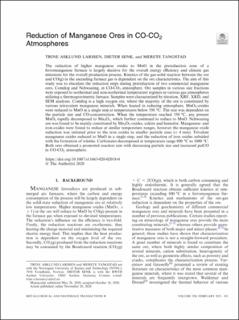| dc.contributor.author | Larssen, Trine Asklund | |
| dc.contributor.author | Senk, Dieter | |
| dc.contributor.author | Tangstad, Merete | |
| dc.date.accessioned | 2022-02-15T08:46:51Z | |
| dc.date.available | 2022-02-15T08:46:51Z | |
| dc.date.created | 2021-05-11T16:45:49Z | |
| dc.date.issued | 2021 | |
| dc.identifier.citation | Metallurgical and Materials Transactions B. 2021, 52B (1), 363-381. | en_US |
| dc.identifier.issn | 1073-5615 | |
| dc.identifier.uri | https://hdl.handle.net/11250/2978972 | |
| dc.description.abstract | The reduction of higher manganese oxides to MnO in the prereduction zone of a ferromanganese furnace is largely decisive for the overall energy efficiency and climate gas emissions for the overall production process. Kinetics of the gas-solid reaction between the ore and CO(g) in the ascending furnace gas is dependent on the ore characteristics. The aim of this study was to elucidate the reduction steps during prereduction of two commercial manganese ores, Comilog and Nchwaning, in CO-CO2 atmosphere. Ore samples in various size fractions were exposed to isothermal and non-isothermal temperature regimes in various gas atmospheres utilizing a thermogravimetric furnace. Samples were characterized by titration, XRF, XRD, and SEM analyses. Comilog is a high oxygen ore, where the majority of the ore is constituted by various tetravalent manganese minerals. When heated in reducing atmosphere, MnO2-oxides were reduced to MnO in a single step at temperatures below 550 °C. The rate was dependent on the particle size and CO-concentration. When the temperature reached 550 °C, any present MnO2 rapidly decomposed to Mn2O3, which further continued to reduce to MnO. Nchwaning ore was found to be mainly constituted by Mn2O3-oxides, calcite and hematite. Manganese- and iron-oxides were found to reduce at similar temperature ranges, however the manganese oxide reduction was initiated prior to the iron oxides in smaller particle sizes (< 4 mm). Trivalent manganese oxides reduced to MnO in a single step, and the reduction of iron oxides subsided with the formation of wüstite. Carbonates decomposed at temperature range 800 °C to 1000 °C. Both ores obtained a promoted reaction rate with decreasing particle size and increased pctCO in CO-CO2 atmosphere. | en_US |
| dc.language.iso | eng | en_US |
| dc.publisher | Springer | en_US |
| dc.rights | Navngivelse 4.0 Internasjonal | * |
| dc.rights.uri | http://creativecommons.org/licenses/by/4.0/deed.no | * |
| dc.title | Reduction of Manganese Ores in CO-CO2 Atmospheres | en_US |
| dc.type | Peer reviewed | en_US |
| dc.type | Journal article | en_US |
| dc.description.version | publishedVersion | en_US |
| dc.source.pagenumber | 363-381 | en_US |
| dc.source.volume | 52B | en_US |
| dc.source.journal | Metallurgical and Materials Transactions B | en_US |
| dc.source.issue | 1 | en_US |
| dc.identifier.doi | 10.1007/s11663-020-02018-0 | |
| dc.identifier.cristin | 1909514 | |
| cristin.ispublished | true | |
| cristin.fulltext | original | |
| cristin.qualitycode | 2 | |

